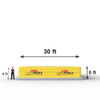Description
Description:
Maximum Height: Rated at 100' (30 m) Comparable to a fall from the 10th floor of an average office building Safety AirPacs are manufactured using fire retardant, 15/18oz vinyl reinforced fabric, per mil spec C 20696 &CC 10-191-5902-5910. Used by fire departments and rescue teams for training and emergencies. Air Packs are designed to accept ONE person at a time and must be fully inflated as per directions in the instruction manual provided with each unit. **Rated height (10’ per floor) is based upon the Air Pack being capable of absorbing a falling body landing on his seat or back from the rated floor level with the cushioning effect that is safely below the human tolerance level (as per data published by the U.S. Air Force on “Human Tolerance to Shock.”) WARNING: No risk is assumed by Impact Air Bags, LLC, i2k , i2k AirPad or any of its associates as it is impossible to control how each individual may land or to know of any special physical reactions of any individual’s body. All models have been designed and tested to absorb the energy due to falls from the floor levels specified. Inflated Dimensions: 20'x 25'x9' (6.1*7.6*2.8m) Weight


















